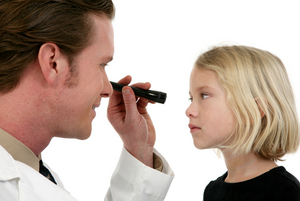Pink eye is a less technical term for a condition known as conjunctivitis, where the membrane the lines your eyeball and eyelid is inflamed or infected. Pink eye is highly contagious; children are often sent home from school with the affliction. Pink eye results from a bacterial or a viral infection, and it may crop up in newborns that suffer from an incompletely opened tear duct. Even though pink eye can be quite irritating, it rarely has any adverse effects on a person’s eyesight. Bacterial pink eye can be cleared up in short order in most cases with the use of medicated eye drops or ointments, whereas the viral version has to run its course before disappearing.
Viruses are at the root of most instances of pink eye, producing a watery mucous discharge from one or both eyes. Bacterial pink eye cases will be associated with a thicker, yellow-greenish discharge and may come along as a side effect of a respiratory infection or sore throat. Both types of pink eye can accompany colds, and they both are extremely contagious. Although young and old can have pink eye, children are more susceptible to the bacterial kind. Pink eye can also be brought about by allergic reactions to substances in the air, with pollen one example of such an irritant. Allergic pink eye reactions can precipitate itching, to go along with the redness and inflammation of the eyelids.
Symptoms of pink eye, which can affect one or both eyes, include the obvious pinkish or reddish color of the eye, along with an itchy sensation in the affected eyes. It can feel as if there is something in the eye when this is not the actual case, and when you wake up in the morning, you may find your eyelids are stuck shut, as the discharge has dried while you sleep. Bacterial pink eye will have the thick discharge; viral or allergic pink eye will have a clear one. In some cases of pink eye the vision is somewhat blurred, and there is a sensitivity to exposure to light. The symptoms of other eye maladies such as a sty, or infection of the skin around the eyelid, can be mistaken for those of pink eye, but the discharge involved with pink eye often give it away, as does having pain in the eye in the presence of bright light.
Antibiotic eye drops can handle a bacterially induced case of pink eye, clearing the infection up in a few days. Antibiotic ointments are available for younger children, who often find it hard to stay still long enough to allow eye drops to be properly administered. These remedies should improve the pink eye symptoms within a couple of days, but always use the entire prescription to stop the infection from returning. Viral pink eye is resistant to antibiotic treatments, and must be allowed to simply play itself out, sometimes lasting as long as three weeks. The symptoms associated with bacterial pink eye can be relieved by over-the-counter products.
If you are told you have pink eye, there are several things you can do to avoid giving it to a family member or co-worker. Do not touch your eyes with your hands, and always wash your hands meticulously and often. Towels and washcloths should go right into the laundry and not be shared with others, and your pillow case should be changed frequently, as it will have discharge from your infected eyes on it. Get rid of all of your eye cosmetics, especially mascara, which could easily be contaminated, and never share your eye cosmetics with others. If you where contacts, you will be advised not to do so until after the pink eye has gone. Keep your kids with pink eye home until your doctor tells you it is okay for them to return to school or child care. Artificial tears can provide some relief from itching and irritation when you have pink eye, as can a washcloth soaked in lukewarm water used as a compress a few times a day. Physicians warn to never use an eye patch if you have pink eye, as it can make things worse rather than better. One helpful hint to those who share computer keyboards with others at work is to always wash your hands after doing so, in an attempt to cut down your chances of contracting pink eye.
Newborn babies are at risk from bacteria that are living in their mother’s birth canal, organisms that do not affect the mother but can cause a serious form of conjunctivitis known as pothalmia neonatorium. This affliction can have a serious impact on a baby’s eyesight, and needs to be treated immediately. The threat of this form of pink eye is why newborn’s eyes are treated with an application of a preventative medicating ointment right after they are born. The greatest long term threat to adults from pink eye is when a serious infection develops due to not treating the condition, which can then cause damage to the cornea.


